July, 1931
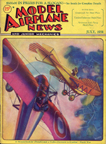
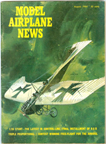
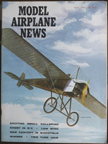
Morane-Saulnier Type G and Etrich Taube
Model Airplane News Cover Art for July, 1931, August, 1964 and April, 1965
by Jo Kotula
Click to Enlarge
This cover shows the "dawn" of air-to air combat in which aviators in flimsy wood and cloth kites took potshots at each other with samll arms. The two aircraft are only incremental improvements on the Wright Brothers original airplane. Both were subjects for the M.A.N. cover during the historical retrospective period of the 1960s. The [French] Morane-Saulnier Type G was on the cover of the April, 1965 issue while the [German] Etrich Taube graced the cover of the August, 1964 issue. Lterally, both Saunier and Etrich had been designing kites and gliders just a few years before World War One began.
The Morane-Saulnier Type G
Click here to read about the Etrich Taube
Aéroplanes Morane-Saulnier is a French aircraft manufacturer formed by Raymond Saulnier(1881-1964) and the Morane Brothers Leon(1885-1918) and Robert(1886-1968) in October 1911. The company was taken over and diversified in the 1960s.
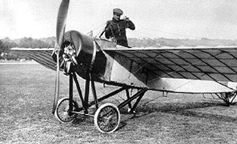
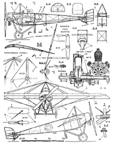
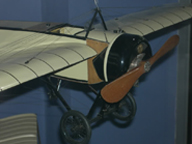
Morane Saulnier Type G
The drawing makes more sense if you can read Russian...
Click to Enlarge
The Morane-Saulnier Type G was a sport aircraft produced in France in the years before the First World War. It was a conventional, wire-braced, shoulder-wing design. Construction was of fabric-covered wood throughout, except for the undercarriage struts which were of steel tube.
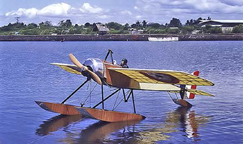
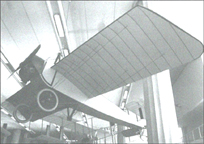
Morane Saulnier Type G Floatplane Version
Click to Enlarge
The type was a sporting success. In April 1913, Roland Garros took second place in the inaugural Schneider Cup in a floatplane versions. In June, Claude Grahame-White flew another float-equipped example from Paris to London via Le Havre, Boulogne-sur-Mer, and Dover, covering some 300 miles in a day. In September, two float-equipped Type Gs competed at the seaplane meeting at San Sebastián, with Lord Carbery winning the short take-off prize on one, and Edmond Audemars winning the maneuverability prize on the other. The following week, Carbery flew his Type G in the Italian Waterplane Contest from Lake Como to Pavia and back, along with two other Type Gs in the field of fifteen competitors, these flown by Garros and Morane. Garros not only won the Grand Prize in the "general class", but also the prizes for best speed (79.8 mph) and greatest altitude (6,000 ft).
In 1914, Russian manufacturer Duks arranged to build the type under licence at their Moscow factory for the Russian Army, and the same year, the Turkish military ordered 40 examples. Before these could be delivered, however, war broke out, and the aircraft were impressed into the French Army. To these, the Army soon added an order of 94 aircraft, and the British Royal Flying Corps also acquired a number, these latter machines purchased from Grahame-White, who was manufacturing the type in the UK under licence. At the outbreak of war, the type's military value was found to be wanting, and the French machines were quickly relegated to training duties.
Here is a video of a replica of the Morane Saulnier Type G :
Click Here for more information about the Morane Saulnier Type G.
Etrich Taube
Click here to read about The Morane-Saulnier Type G
The Etrich Taube was a pre-World War I monoplane aircraft, and the first mass-produced military plane in Germany. Being the Germans' first practical military plane, the Taube ("dove") was used for all common military aircraft applications, including as a fighter, bomber, surveillance plane and trainer from its first flight in 1910 until the beginning of World War I. The plane was very popular in the years immediately prior to the First World War, and was used by the air forces of Italy, Germany and Austria-Hungary. By 1914, however, it quickly proved lacking as a serious warplane, and was soon superseded.
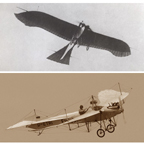

Photos of the Etrich-Rumpler "Taube"
Click to Enlarge
The plane was developed by Igo Etrich from Austria in 1909, with the first flight in 1910. The design was licensed for serial production by Lohner in Austria and Edmund Rumpler in Germany, and called the Etrich-Rumpler-Taube However, Rumpler soon changed the name to Rumpler-Taube, and stopped paying royalties to Etrich.
Despite its name, the Taube's unique wing form was not modeled after that of a bird, but after the Zanonia macrocarpa seeds, which glide to the ground in a slow spin induced by a single wing. Similar wing shapes have also been used by Karl Jatho. While Etrich had tried to build a flying wing aircraft based on the Zanonia wing shape, the more conventional Taube type, with "normal" tail controls was much more successful. Like many contemporary aircraft, especially monoplanes, the Taube used wing warping rather than ailerons for lateral (roll) control, and also warped the rear half of the stabilizer for use as an elevator function. The design provided for very stable flight, suitable for observation. In addition, the translucent wings made it difficult for ground based observers to detect a Taube at an altitude above 400m. The French called it "the Invisible Aircraft", and it is sometimes also referred to as the "world's first stealth plane". The first hostile engagement was an Italian Taube in 1911 in Libya, using pistols and 2 kg bombs. Taube airplanes were able to detect the advancing Russian army during the Battle of Tannenberg. The plane was also used for bombing, when the pilot dropped small bombs in the Balkans in 1911 and 3 kg bomblets and propaganda leaflets over Paris in 1914.
Here is a video of a replica ofthe Etrich-Rumpler "Taube":
Click Here for more information about the Etrich-Rumpler "Taube".

Click to go back and select another cover.
Counter for the Entire Site (not just this page..)
Home | About Lindy | Last Week's Reviews | Upcoming Events | 1940s Collecibles
The Guide - Establishments - Travel - Accessories
Music | Links | Photo Gallery | Extras | Contact